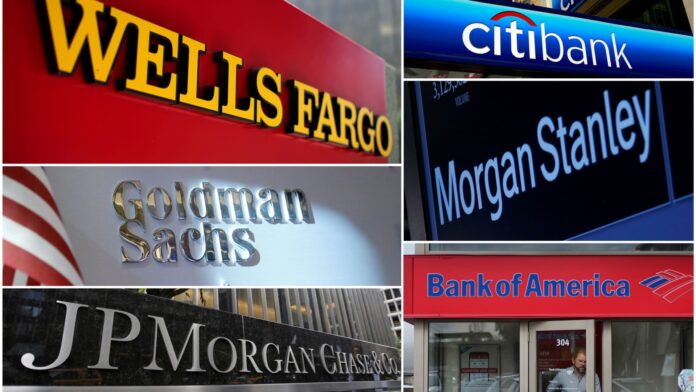Bank stocks remain under pressure due to high interest rates as financial companies such as club holdings Wells Fargo (WFC) and Morgan Stanley (MS) prepare for the start of earnings season. Like other major banks, Wells Fargo and Morgan Stanley have been hit by the central bank’s interest rate hike campaign over the past 18 months. Both have scaled back lending to be more conservative with their capital as credit conditions have tightened – with a potentially negative impact on revenue streams and overall profits when the companies report earnings in the coming days. “I increasingly think that the only thing that can make a difference at both banks is the end of the tightening cycle so that people don’t have to worry as much about credit problems,” Jim Cramer said Wednesday. As part of its efforts to combat persistent inflation, the Fed has raised its key interest rate 11 times since March 2022, with rates reaching their highest level in 22 years. Aside from operating in a high-yield environment, financial firms are still recovering from the collapse of a number of regional lenders, starting with the closure of Silicon Valley Bank (SVB) in March. Wells Fargo and Morgan Stanley were in the red year-on-year against the difficult backdrop, falling 4.3% and 8.6%, respectively. The KBW Bank Index, a banking sector benchmark stock index, has lost more than 24% since the start of the year. Nevertheless, both club banks have solid fundamentals and diverse sources of income, which make us optimistic in the long term. Wells Fargo is expected to report third-quarter results before the opening bell on Friday, while Morgan Stanley is expected to report results next Wednesday. WFC YTD Mountain Wells Fargo (WFC) Year-to-Date Performance For the three months ended September 30, analysts expect Well Fargo to report revenue of $20.1 billion, compared with $19.5 billion in the same period last year, according to Refinitiv. Earnings per share are expected to be $1.24, up 45% from a year earlier, Refinitiv estimates showed. Wells Fargo’s cost-cutting measures and its outlook for its home loans will be in focus on Friday. Of the major U.S. banks, Wells Fargo has been hit hardest by the troubled commercial real estate market, an industry suffering from higher interest rates and near-record office vacancies. Offices account for approximately 22% of Wells Fargo’s outstanding commercial real estate loans and 3% of its total loan portfolio. In the bank’s July earnings report, CEO Charlie Scharf said Wells Fargo had experienced “higher losses in commercial real estate, particularly in the office portfolio,” adding that while there have been “significant losses in our office portfolio to date, we are taking reservations.” [capital] “Wells Fargo continues to focus on making the business more efficient and has been reducing headcount since the third quarter of 2020,” Barclays analysts wrote in a recent September note. Chief Financial Officer Mike Santomassimo said the bank could add to the nearly 40,000 layoffs in the have further reduced the number of their employees over the last three years. Meanwhile, Wells Fargo has significantly slowed the pace of its share repurchases in recent quarters, even though the stock is at a low $1,000 price and the bank remains well capitalized. “My hope is that it will happen this Friday.” [Scharf] “Change his mind when the company reports and it can soak up the excess stock,” Jim said. Scharf “has repurchased 300 million shares since taking over in 2019, nearly a tenth of the share count,” Jim added. MS YTD Berg Morgan Stanley (MS) Year-to-Date Performance For the three months ended September 30, analysts expect Morgan Stanley to report revenue of $13.2 billion, up from $12.9 billion in the three months ended September 30, according to Refinitiv same period last year – shares were expected to fall 16% year-over-year to $1.28. In recent quarters, Morgan Stanley’s investment banking business – once crucial to its bottom line – has lagged due to macroeconomic uncertainty. Companies have withdrawn mergers and acquisitions as concerns grow that a recession is imminent. In fact, the value of global M&A fell 44% in the first five months of 2023, according to data analytics firm GlobalData. At a recent conference, Morgan Stanley executives said capital markets are expected to improve in 2024, potentially setting up its investment banking division for a stronger year. The bank said it was “more confident now than at any point this year about the improved outlook for 2024.” Morgan Stanley has adapted to the challenging M&A and IPO markets by increasing its focus on asset management. This strategy, in our view, highlights the bank’s ability to deftly navigate a range of headwinds. “Morgan Stanley is doing everything it can to be less of a bank and more of a financial advisor,” Jim said Wednesday. And with CEO James Gorman expected to retire early next year, we will be seeking further guidance from the company on his succession plans. (Jim Cramer’s Charitable Trust is called WFC, MS. A full list of stocks can be found here.) As a subscriber to CNBC Investing Club with Jim Cramer, you will receive a trade alert before Jim makes a trade. Jim waits 45 minutes after sending a trade alert before buying or selling a stock in his charitable foundation’s portfolio. If Jim discussed a stock on CNBC television, he waits 72 hours after the trade alert is issued before executing the trade. THE INVESTING CLUB INFORMATION SET FORTH ABOVE IS SUBJECT TO OUR TERMS AND CONDITIONS AND PRIVACY POLICY, ALONG WITH OUR DISCLAIMER. THERE ARE NO fiduciary duty or duty IN RECEIVING YOUR INFORMATION PROVIDED IN CONNECTION WITH THE INVESTMENT CLUB. NO SPECIFIC RESULTS OR PROFITS ARE GUARANTEED.
A combination photo shows Wells Fargo, Citibank, Morgan Stanley, JPMorgan Chase, Bank of America and Goldman Sachs.
Reuters
Bank stocks remain under pressure due to high interest rates as financial firms favor club holdings Wells Fargo (WFC) and Morgan Stanley (MS) Get ready for earnings season to begin.















